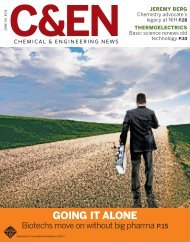Chemical & Engineering News Digital Edition - Institute of Materia ...
Chemical & Engineering News Digital Edition - Institute of Materia ...
Chemical & Engineering News Digital Edition - Institute of Materia ...
You also want an ePaper? Increase the reach of your titles
YUMPU automatically turns print PDFs into web optimized ePapers that Google loves.
REQUEST MORE AT ADINFONOW.ORG<br />
Targanta is in the camp that believes<br />
natural products will continue to be<br />
the way forward, although it does keep<br />
an eye on newer tools. The company<br />
is devoting the bulk <strong>of</strong> its resources to<br />
bringing oritavancin, a semisynthetic<br />
glycopeptide licensed from Lilly, to<br />
market. The Cambridge, Mass.-based<br />
biotech filed a New Drug Application<br />
with the Food & Drug Administration<br />
in January and is expecting a response<br />
by December so that the drug could<br />
launch in 2009.<br />
Even Targanta’s earlier-stage efforts<br />
are focused on derivatives <strong>of</strong> natural<br />
products. “The bugs are smarter than<br />
the chemists,” Parr says. “I think there<br />
is still great promise to find things by<br />
looking to nature.” The challenge, he<br />
adds, will be to accelerate the process <strong>of</strong><br />
sifting through natural products to find<br />
useful molecules while figuring out how to<br />
streamline the chemistry needed to turn<br />
those molecules into drugs.<br />
Meanwhile, Boston-based Paratek is<br />
mining an older natural product class that<br />
it believes has not been fully exploited.<br />
15<br />
10<br />
5<br />
0<br />
COVER STORY<br />
SHRINKING ARSENAL<br />
Antibacterial drug approvals are on the<br />
decline in the U.S.<br />
Antibacterial drug approvals<br />
20<br />
1983–87 1988–92 1993–97 1998–02 2003–07<br />
SOURCE: Infectious Diseases Society <strong>of</strong> America<br />
The company’s lead molecule is a derivative<br />
<strong>of</strong> tetracycline, an antibiotic that hit<br />
the market in the 1950s. However, little<br />
new chemistry has been introduced since<br />
then to overcome resistance or other issues<br />
with the drug. Paratek chemists made<br />
thousands <strong>of</strong> tetracycline derivatives to try<br />
to cut resistance while preserving antibac-<br />
WWW.CEN-ONLINE.ORG 18 APRIL 14, 2008<br />
terial activity. Eventually, they hit on<br />
some promising compounds.<br />
“This four-ring structure has a lot<br />
going for it,” Levy says <strong>of</strong> tetracycline.<br />
His team is now analyzing the data<br />
from Phase II trials <strong>of</strong> PTK-0796, a<br />
broad-spectrum derivative for intravenous<br />
and oral use.<br />
Optimer, meanwhile, is focused<br />
on developing narrow, or at least<br />
narrower, spectrum antibiotics that<br />
take out just one or two pathogens;<br />
broad-spectrum drugs, in contrast,<br />
use brute force to wipe out a range <strong>of</strong><br />
bugs that may be causing an infection.<br />
The narrower approach is not useful in<br />
all settings, concedes Michael Chang,<br />
Optimer’s president and CEO, particularly<br />
in the absence <strong>of</strong> rapid diagnostics<br />
to detect the specific bacteria infecting a<br />
patient. But certain indications in patients<br />
call for narrow-spectrum drugs, and with<br />
fewer targets to hit, researchers could have<br />
an easier time designing them.<br />
The San Diego-based firm’s lead compound,<br />
OPT-80, is an 18-membered macrocycle<br />
that treats Clostridium difficile infection<br />
(CDI), an infection in the lining <strong>of</strong> the colon<br />
that is a prime candidate for a narrow-spectrum<br />
drug. A broad-spectrum antibiotic like<br />
vancomycin, currently the only approved<br />
treatment for CDI, kills most <strong>of</strong> the flora in<br />
the gut, but C. difficile protects itself by forming<br />
spores. When antibiotic use is stopped,<br />
the C. difficile grows again, and this time its<br />
growth isn’t tempered by other bugs. “It<br />
grows with a vengeance,” Chang says.<br />
OPT-80 would be the first very-narrowspectrum<br />
antibiotic on the market, Chang<br />
says. The drug is currently in two Phase III<br />
trials; results from the first trial are expected<br />
in 2008 and from the second in the first<br />
half <strong>of</strong> 2009. If all goes well with the trials<br />
and regulatory authorities, the drug could<br />
hit the market by 2010.<br />
Replidyne is also exploring a narrowspectrum<br />
approach as part <strong>of</strong> its overall<br />
R&D strategy. The Louisville, Colo.-based<br />
company identified a compound against C.<br />
difficile from assets it licensed from Glaxo-<br />
SmithKline. The compound blocks methionyl<br />
transfer RNA synthetase, an enzyme<br />
involved in synthesizing proteins. By halting<br />
the production <strong>of</strong> toxic proteins, the<br />
drug renders the bacteria harmless, says<br />
Nebojsa Janjic, Replidyne’s chief scientific<br />
<strong>of</strong>ficer. The company plans to file an Investigational<br />
New Drug (IND) application<br />
with FDA, the first step in initiating human<br />
tests <strong>of</strong> the drug, by the end <strong>of</strong> the year.

















